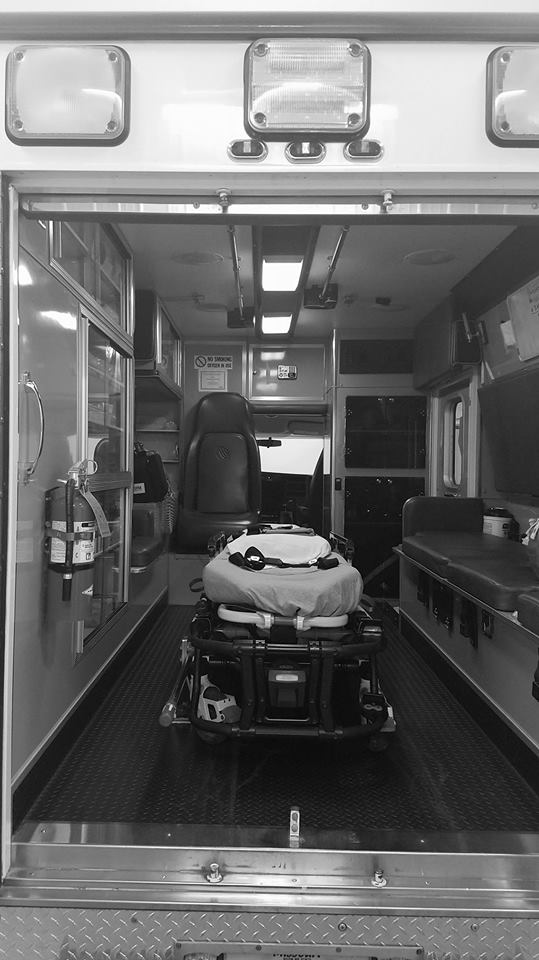-
Posts
64 -
Joined
-
Last visited
-
Days Won
3
jwiley40 last won the day on March 4 2016
jwiley40 had the most liked content!
About jwiley40
- Birthday November 20
Previous Fields
-
Occupation
NREMT-P, Intensive Care Technician, retired Soldier, husband and chef.
Profile Information
-
Gender
Male
-
Location
MO
-
Interests
Family, God, work and Cardinals baseball....order will shift depending on the day/time of year!
jwiley40's Achievements
Newbie (1/14)
7
Reputation
-
jwiley40 started following Handtevy System for Pediatrics , Panasonic Toughbook vs. a pad (any brand) , Why is O2 required in this case? and 4 others
-
My old service upgraded to HP. They were bigger and supposed to be tougher. Yeah. We broke one.
-
This sounds like a question that needs to be directed to your medical director. As an instructor/preceptor, we taught that if the patient's Spo2 was 94% or greater, you don't really need to apply O2, unless they are having increased difficulty in breathing. Then, you could to supplement and stave off hypoxia. However, based in the scenario you provided, not enough information noted. Remember this though: treat the patient, not the equipment unless you're an equipment technician. But like I stated in the beginning, this sounds like a question for your medical director.
-

Problems Getting to Your Phone
jwiley40 replied to TheWolfman2112's topic in Equiqment and Apparatus
A service I used to work for put phones on the trucks to be able to do much of what you're talking about but not strapped to your forearm. You could carry it in (which I didn't), use it to take pictures of an MVC to send to trauma team (again, I never did), and send up reports while enroute to the ED (which I did do). I think that if you're thinking of using a phone for communication while on scene, that's inappropriate. Especially is in contact with family. I tend to think that sort of activity should be done away for others not connected with the family. These phones could be a good thing for EMS because they can help to record situations or conditions that contribute to the situation, such as ice, snow, etc. You can use them to transmit ECG's and other information to the ED. But in the event of a acute situation where your entire focus needs to be in the patient, drop the damn phone. You have the radio. Use it. We have become so reliant on our telephones and the computers we work with that if your systems dropped for whatever reason, I wonder how many of us could actually write a written report. I could, but I doubt anyone could read it. Trust me. Twenty one years in the Army and seventeen years in health care have destroyed my penmanship!! Before I left, I went back to using the radio to give report because it gave me the connection with the people I was going to hand my patient off to. Oooooor, I could be way off base. Just saying..... -
I'm detailed to the ICU right now. When we are in direct contact with patients, minimum of surgical mask. Unless a COVID patient, then the full PPE with PAPR's. Our medics on the units must wear N95's with ALL patient's. ER policy.
-
It would be nice to get hazard pay, but many services, especially those that are tax based, would lose money and have to cut services. Corporate services could afford it, but would prefer not to pay it and would cut hours first. But, in answer to your question, it truly depends on where the heck you're working. NYC EMS, Chicago, LA, St Louis and other hard hit cities deserve it. Pay them!! Washing your hands would help curb the spread but so does the social distancing and the stay at home orders (which many in my town seem to think does not apply to them!). When I started EMS in 2003, I understood what I was getting myself into. I was raised in a medical family. Mom and Grandma washed their hands incessantly and so did I until I joined the Army. Hard to wash your hands all the time. And hand sanitizer does not travel well in a rucksack. Just saying. As I progressed in this profession, I understood how much could be spread by your hands and that keeping them clean was important. It's a point I stressed to my students when I was precepting them. I made sure they all understood that an epidemic (or pandemic) could easily start. Wash your hands after every patient.
-
Been away for four long years. For some reason, an email popped up and reminded me of the site. I totally forgot about EMTcity! I'm back and plan on checking in more often.
-
Morning all, from cold and icy Missouri! The service I work for has shifted in the last year from Broselow to Handtevy for treatment of pediatrics. In a nutshell, it cuts back on the need to do all of the calculations, especially if you're in a very stressful situation. It works more with milliliters than milligrams. Volume over dosage. With the addition of the app for our phones, I can have a pretty good idea of how much of a specific medication I would need to give BEFORE I arrive n scene. If anyone else is using it, how do you feel about it? Has it helped you? I have been off EMTcity for a few years so if it has been addressed, sorry to bring it back up. Thanks!!
-
jwiley40 changed their profile photo
-
Diphenhydramine (Benadryl) when given by a medic is in IV form, not a syrup like you find at home. Yup, it'll make you sleepy, but it stops the histamine release. Epinephren 1:1000 given subcutaneously is the first line medication in anaphylaxis, as it relaxes the smooth muscles. The two meds working together will bring relief to the patient.
-
When I worked as a medic in an ED (US military hospital as a civilian medic), I ran calls and worked in the ED, assisting nurses and doctors. However, we were restricted to performing only within the limits of our licensure. In other words, if we could do it on the trucks, we could do it in the ED. As for meds, if it wasn't on our ambulance, we didn't administer it. Breathing treatments, IV medications such as Cardizem or RSI meds, we gave. We could not perform suturing, even if we were certified to do so. If it wasn't in the scope of practice or on the job description, it wasn't done in the ED.
-

Use of the Broselow Tape May Under Resuscitate Children
jwiley40 replied to jwiley40's topic in Patient Care
It's either what they're eating OR how much they eat. There is one thing I have learned in all my time working in rural EMs: farm kids always seem to be much bigger than the city kids I have met. I'm not entirely sure if it's a combination of hard work and good old fashioned home cooking, or if it's simply that they eat more than we did as kids. I took care of a fourteen year old boy that was taller and bigger than I was when I joined the Army in 1982! he was longer than my cot! Arctickat, thank you for the leads! They will be most helpful. You rock!! To all of the members of this page, if I haven't said it before, I will now: Thank you all! You have always been a source that gives me some seriuos guidence. I still pursue the subject I ask about, but you all give me a better direction. That is where I want to be in the very near future. Even after 7 years, I still have much to learn. -

Use of the Broselow Tape May Under Resuscitate Children
jwiley40 replied to jwiley40's topic in Patient Care
Yikes! That's a problem. And that's why I put this out there. I can't seem to find it anywhere, the full study with all the results and data. But I have to agree with the information presented in the paragraph. However, I have to follow the protocols of my service and the new service I'm getting ready to work for. I would like to be able to present the information to my new supervisors. -
To all here: I was looking up information on IO infusion for peds and ran across a short paragraph from 2006 that says the Broselow Tape may under-resuscitate children. Here is that paragraph: Registered nurse Carolyn Nieman (In Memoriam) discovered that sometimes motherhood is the mother of invention. Ms. Nieman, who served as an ACNP/flight nurse specialist for Metro Life Flight and faculty at Case's FPB School of Nursing, presented her project “Use of the Broselow Tape May Under Resuscitate Children,” for which she shared credit with seven other researchers at the 2003 Research ShowCASE. While watching her then-thirteen-year-old daughter and ten-year-old son perform at a school concert, she first thought of the idea that she displayed at the showcase. Soon afterward, she began devising a way to improve on the “Broselow Tape” method traditionally used in emergency medical situations involving children requiring resuscitation. The method is used to estimate medication dosing and equipment sizing based on a child’s age and body size. “I always thought my kids were normal size, but that night they seemed so much smaller than everyone else on stage,” she said. “So when I came to work, I started thinking there’s no way that the Broselow Tape can be accurate anymore, and it became more clear to me everywhere I went that kids seemed bigger and bigger.” She enlisted the help of several other flight nurses she worked with to research the current accuracy of the Broselow Tape, which had never been validated in a pediatric population, according to Ms. Nieman. The team worked to correlate the device against a large sample of children. Their research analyzed measurements of about 1,150 children ages 5 to 11 from several Greater Cleveland schools, as well as the database numbers for the MetroHealth System’s measurements of children from birth to age 11 taken during annual well-child visits. The team collected enough height and weight data to conclude that less than fifty percent of pediatric patients today would receive an accurate dosage estimate based on the Broselow system, especially children who are older or heavier. Ms. Nieman’s research group is in the process of completing its research paper and getting it published, which they hope to do this summer. “We want to get the word out to people in emergency medical systems, fire departments, emergency rooms, and so on, so they can determine what they want to do with the information,” she says. Nieman CT, Manacci CF, Super DM, Mancuso C & Fallon WF. (2006). Use of the Broselow tape may result in underresuscitation of children. Academic Emergency Medicine, 13, 1011-1019. I have looked on Google, Bing and in medical search engines trying to find more information. If anyone can point me in the right direction, I would be most appreciative. I would like to think that when I have to resuscitate a pediatric patient, that I use every tool in my tool-kit to do it.
-
Sometimes the best way to learn!
-
For me, load and go and perform an ALS intercept. At least get the patient moving to definitive care. By the way, I have learned from my last foray into the scenario world: stay heck away from abbreviations!
-
I'm learning that..... Teaching point for myself.


